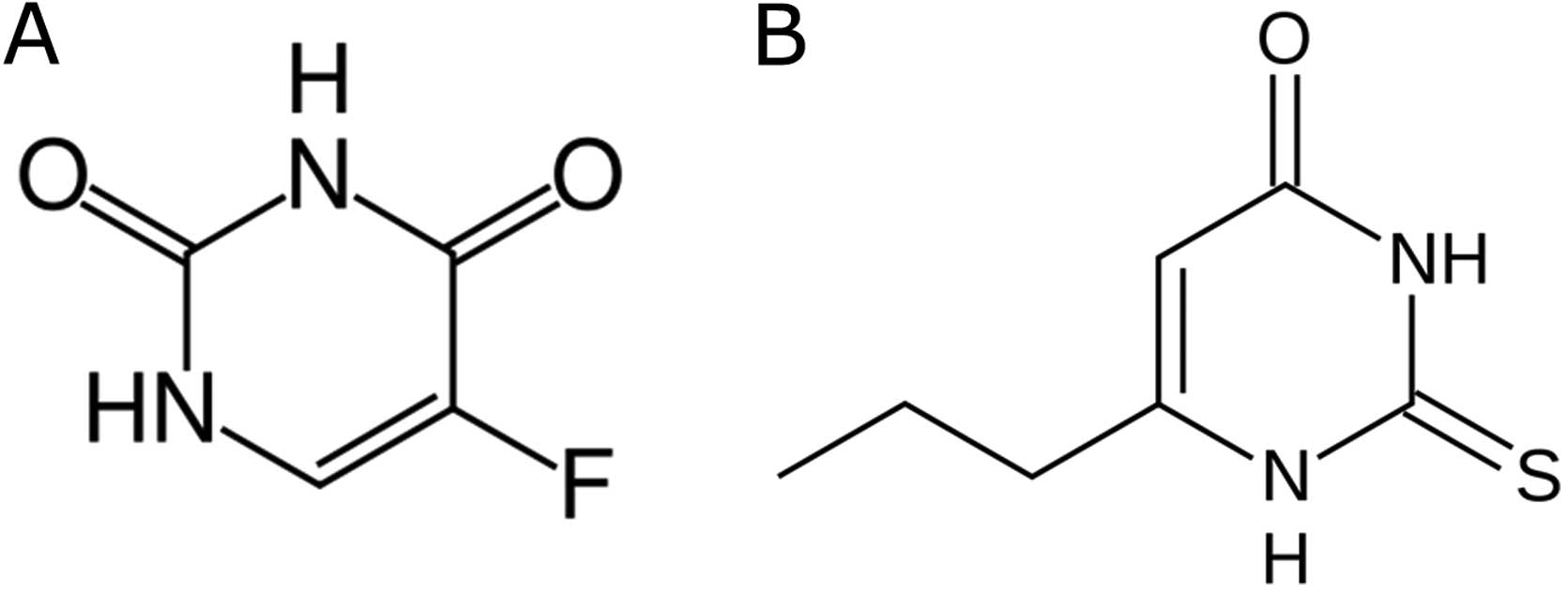|
1
|
Feldt S, Schüssel K, Quinzler R, et al:
Incidence of thyroid hormone therapy in patients treated with
sunitinib or sorafenib: a cohort study. Eur J Cancer. 48:974–981.
2012. View Article : Google Scholar : PubMed/NCBI
|
|
2
|
Torino F, Corsello SM, Longo R, Barnabei A
and Gasparini G: Hypothyroidism related to tyrosine kinase
inhibitors: an emerging toxic effect of targeted therapy. Nat Rev
Clin Oncol. 6:219–228. 2009. View Article : Google Scholar : PubMed/NCBI
|
|
3
|
Desai J, Yassa L, Marqusee E, et al:
Hypothyroidism after sunitinib treatment for patients with
gastrointestinal stromal tumors. Ann Intern Med. 145:660–664. 2006.
View Article : Google Scholar : PubMed/NCBI
|
|
4
|
Rini BI, Tamaskar I, Shaheen P, et al:
Hypothyroidism in patients with metastatic renal cell carcinoma
treated with sunitinib. J Natl Cancer Inst. 99:81–83. 2007.
View Article : Google Scholar : PubMed/NCBI
|
|
5
|
Wong E, Rosen LS, Mulay M, et al:
Sunitinib induces hypothyroidism in advanced cancer patients and
may inhibit thyroid peroxidase activity. Thyroid. 17:351–355. 2007.
View Article : Google Scholar : PubMed/NCBI
|
|
6
|
Faris JE, Moore AF and Daniels GH:
Sunitinib (Sutent)-induced thyrotoxicosis due to destructive
thyroiditis: a case report. Thyroid. 17:1147–1149. 2007. View Article : Google Scholar : PubMed/NCBI
|
|
7
|
Abdulrahman RM, Verloop H, Hoftijzer H, et
al: Sorafenib- induced hypothyroidism is associated with increased
type 3 deiodination. J Clin Endocrinol Metab. 95:3758–3762. 2010.
View Article : Google Scholar : PubMed/NCBI
|
|
8
|
Tamaskar I, Bukowski R, Elson P, et al:
Thyroid function test abnormalities in patients with metastatic
renal cell carcinoma treated with sorafenib. Ann Oncol. 19:265–268.
2008. View Article : Google Scholar : PubMed/NCBI
|
|
9
|
de Groot JW, Zonnenberg BA, Plukker JT,
van Der Graaf WT and Links TP: Imatinib induces hypothyroidism in
patients receiving levothyroxine. Clin Pharmacol Ther. 78:433–438.
2005.PubMed/NCBI
|
|
10
|
de Groot JW, Zonnenberg BA, van
Ufford-Mannesse PQ, et al: A phase II trial of imatinib therapy for
metastatic medullary thyroid carcinoma. J Clin Endocrinol Metab.
92:3466–3469. 2007.PubMed/NCBI
|
|
11
|
Hollowell JG, Staehling NW, Flanders WD,
et al: Serum TSH, T(4), and thyroid antibodies in the United States
population (1988 to 1994): National Health and Nutrition
Examination Survey (NHANES III). J Clin Endocrinol Metab.
87:489–499. 2002. View Article : Google Scholar
|
|
12
|
Eisen T, Sternberg CN, Robert C, et al:
Targeted therapies for renal cell carcinoma: review of adverse
event management strategies. J Natl Cancer Inst. 104:93–113. 2012.
View Article : Google Scholar : PubMed/NCBI
|
|
13
|
Iavarone M, Perrino M, Viganò M,
Beck-Peccoz P and Fugazzola L: Sorafenib-induced destructive
thyroiditis. Thyroid. 20:1043–1044. 2010. View Article : Google Scholar
|
|
14
|
Kappers MH, van Esch JH, Smedts FM, et al:
Sunitinib-induced hypothyroidism is due to induction of type 3
deiodinase activity and thyroidal capillary regression. J Clin
Endocrinol Metab. 96:3087–3094. 2011. View Article : Google Scholar : PubMed/NCBI
|
|
15
|
Shinohara N, Takahashi M, Kamishima T, et
al: The incidence and mechanism of sunitinib-induced thyroid
atrophy in patients with metastatic renal cell carcinoma. Br J
Cancer. 104:241–247. 2011. View Article : Google Scholar : PubMed/NCBI
|
|
16
|
Kim S, Yazici YD, Calzada G, et al:
Sorafenib inhibits the angiogenesis and growth of orthotopic
anaplastic thyroid carcinoma xenografts in nude mice. Mol Cancer
Ther. 6:1785–1792. 2007. View Article : Google Scholar : PubMed/NCBI
|
|
17
|
Saltz LB, Clarke S, Díaz-Rubio E, et al:
Bevacizumab in combination with oxaliplatin-based chemotherapy as
first-line therapy in metastatic colorectal cancer: a randomized
phase III study. J Clin Oncol. 26:2013–2019. 2008. View Article : Google Scholar : PubMed/NCBI
|
|
18
|
Sandler A: Bevacizumab in non-small cell
lung cancer. Clin Cancer Res. 13:s4613–s4616. 2007. View Article : Google Scholar : PubMed/NCBI
|
|
19
|
Miller K, Wang M, Gralow J, et al:
Paclitaxel plus bevacizumab versus paclitaxel alone for metastatic
breast cancer. N Engl J Med. 357:2666–2676. 2007. View Article : Google Scholar : PubMed/NCBI
|
|
20
|
Van Meter ME and Kim ES: Bevacizumab:
current updates in treatment. Curr Opin Oncol. 22:586–591.
2010.PubMed/NCBI
|
|
21
|
Therasse P, Arbuck SG, Eisenhauer EA, et
al: New guidelines to evaluate the response to treatment in solid
tumors. European Organization for Research and Treatment of Cancer,
National Cancer Institute of the United States, National Cancer
Institute of Canada. J Natl Cancer Inst. 92:205–216. 2000.
View Article : Google Scholar : PubMed/NCBI
|
|
22
|
Cooper DS: Clinical practice. Subclinical
hypothyroidism. N Engl J Med. 345:260–265. 2001. View Article : Google Scholar : PubMed/NCBI
|
|
23
|
Beex L, Ross A, Smals A and Kloppenborg P:
5-fluorouracil-induced increase of total serum thyroxine and
triiodothyronine. Cancer Treat Rep. 61:1291–1295. 1977.PubMed/NCBI
|
|
24
|
Kamba T and McDonald DM: Mechanisms of
adverse effects of anti-VEGF therapy for cancer. Br J Cancer.
96:1788–1795. 2007. View Article : Google Scholar : PubMed/NCBI
|
|
25
|
Wang JF, Milosveski V, Schramek C, Fong
GH, Becks GP and Hill DJ: Presence and possible role of vascular
endothelial growth factor in thyroid cell growth and function. J
Endocrinol. 157:5–12. 1998. View Article : Google Scholar : PubMed/NCBI
|
|
26
|
Gordon MS, Margolin K, Talpaz M, et al:
Phase I safety and pharmacokinetic study of recombinant human
anti-vascular endothelial growth factor in patients with advanced
cancer. J Clin Oncol. 19:843–850. 2001.PubMed/NCBI
|











